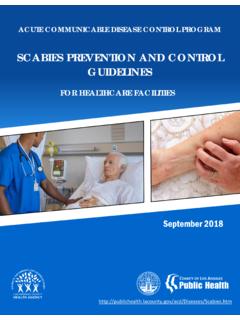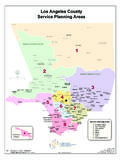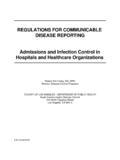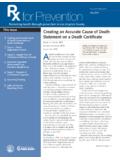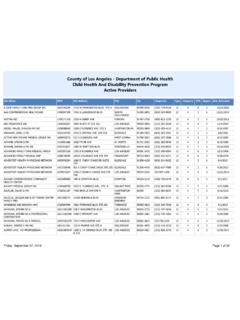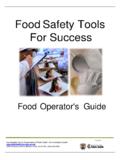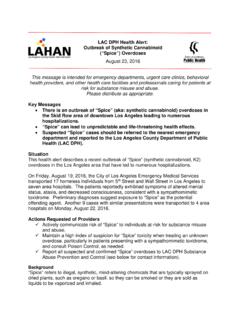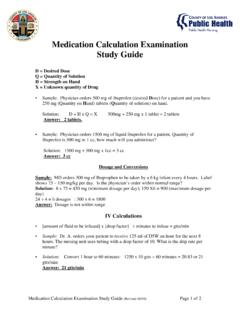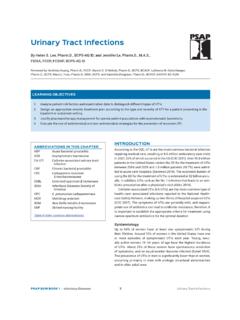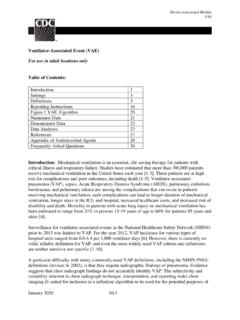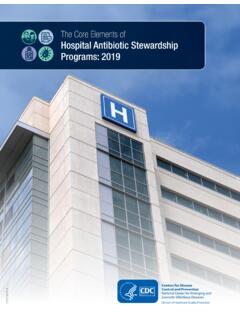Transcription of Epidemiology and Surveillance - Los Angeles County ...
1 Epidemiology and SurveillanceBasics of Infection Prevention 2-Day CourseNovember 2017 Kelsey OYo n gObjectives Discuss basic principles of Epidemiology and how they apply to Surveillance Review basic Surveillance practices: data collection, recording, analysis, interpretation, and communication of Surveillance findings Describe Surveillance process and outcome measures for infection prevention1 Epidemiology Study of factors affecting health of populations In healthcare, answers questions such as: What factors contribute to increased HAI rates? What populations are at higher risk for developing HAIs? What percentage of the time? Allows assessment of trends over time2 Clinical care: focus on the individual vs Epidemiology .
2 Focus on the groupApplying Epidemiology in Healthcare Surveillance Assessment of intervention, new product Outbreak identification3 Infection Prevention and Hospital Epidemiology Goal is prevention of healthcare-associated infections (HAIs) Professional societies include Association for Professionals in Infection Control and Epidemiology (APIC) society for Healthcare Epidemiology of america (SHEA) infectious Diseases society of america (IDSA) Epidemiologic research and Surveillance underlies HAI prevention Data for action4 Surveillance The ongoing, systematiccollection, recording, analysis, interpretationand disseminationof data Reflects rate of disease onset and/or current health/ disease status of a community or population ( healthcare patients) Aims to identify risk factors for disease Used for public health actionto reduce morbidity and mortality, and to improve Measure of central tendency used to describe a data set The average value of a set of numbers Most affected by outliers To calculate.
3 Add the values in the data set Divide by total number of variables7002003721200102468101214 JanFebMarAprMayJunJulAugSepOctNovDecNumb er of CLABSIM onthNumber of CLABSI by month, Hospital LAC, 2015 Calculation(0+0+2+0+0+3+7+2+12+0+0+1)=12 Mean= Another measure of central tendency used to describe a data set The midpoint of a distribution of values To calculate: Order the values in the data set (low to high, or vice versa) Identify middle value8 Calculation0,0,2,0,0,3,7,2,12,0,0,1 Order: 0,0,0,0,0,0,1,2,2,3,7,12 Median= of CLABSIM onthNumber of CLABSI by month, Hospital LAC, 2015 Types of numerical measurements Incidence Prevalence SIR Incidence density rate9 Prevalence Proportion of persons in a population who have a particular disease or attribute at a specified point in time Includes both new and pre-existing casesAll new and pre-existing cases during a given time periodPopulation during the same time period Can be point or period Healthcare Epidemiology example.
4 MRSA admission prevalence rate = 2 patients colonized with MRSA= 10 patients admitted on Mar 31, 201210 Incidence Proportion of an initially disease -free population that develops disease during a specified period of timeNew cases during time periodPopulation during time period Also referred to as attack rate or risk Healthcare Epidemiology example:Colon SSI rate = 8 SSI in 2015 * 100= colon surgeries in 201511 Incidence density rate Measure of incidence that incorporates time directly into the denominator Central line-days, patient-days, person-time Healthcare Epidemiology example:CLABSI rate = 5 CLABSI in 2015 * 10,000= CLABSI per11,400 line-days in 201510,000 central-line days1213 PrevalenceProportion of persons in a population who have a disease or condition at a given point in timeMeasure of infections that are presentIncidenceProportion of persons in a population who develop a disease or condition within a specified period of timeMeasure of newinfectionsIncidence density rateRate of persons in a population who develop a disease or condition within a specified period of person-timeMeasure of newinfectionsConfidence interval, p-value Confidence interval.
5 Range of values to describe uncertainty around a point estimate Measure of variability in data p-value: measure of statistical significance which tells us the probability of an event occurring due to chance alone Range: Common cut-offs: , An investigator found that men with hypertension were twice more likely to develop complications due to a smallpox vaccination than those with normal blood pressure (p= ). There is a 9% chance of finding such an association due to random error in the sample (chance).14 Surveillance A Surveillance system is an informationloop or cycle Starts and ends with communication and action15 Data collectionCollation/ recordingAnalysis and InterpretationDissemination and utilizationEndpoint of HAI Surveillance ?
6 Data that demonstrates progress in HAI prevention!1602468101214 JanFebMarAprMayJunJulAugSepOctNovDecJanF ebMarAprMayJunJulAugSepOctNovDecJanFebMa rAprMayJunJulAugSepOctNumber of CLABSIM onthNumber of CLABSI by month, Hospital LAC, 2013-15 Surveillance Terms Case definition (also called Surveillance definition) the clinical and laboratory characteristics that a patient must have to be counted as a case for Surveillance purposes: Time, place, & person ( , age, sex, other characteristics etc.) Universal case reporting a Surveillance system in which all cases of a disease are supposed to be reported Laboratory-based reporting a Surveillance method in which the reports of cases come from clinical laboratory data (forgoing case review/symptomatology) 17 Quality HAI SurveillanceKey tenets: A written planshould serve as the foundation What HAIs am I tracking?
7 Why? How will data be used? If only to meet mandates, how candata be used? Where are opportunities to prevent HAI in MYfacility? The intensity of Surveillance needs to be maintained over time Stay consistentover time; apply same Surveillance definitions18 ScenarioAs a new, yet prepared, infection preventionist, you are conducting your daily rounds. As you stop by the ICU, a nurse approaches you and voices her concern that there has been a noticeable increase in the number of CLABSIs in that unit. You reply that you will look into the do you start?1920 Resource Recommended Practices for the population the outcome or process for Surveillance Surveillance and analyze infection risk stratification and use Surveillance informationAJIC Am J Infect Control 1998; 26:277-88 AJIC Am J Infect Control 2007; 35:427-4021I.
8 Assess the population Recommended Practices for Surveillance22 Patient Population at Risk for InfectionDo you know: What infections occur most commonly? What infections are likely to occur? Where are greatest opportunities to prevent infections? What are the most frequently performed surgeries or procedures? What types of patients increase liability and/or costs for the facility? 23 Scenario: Assess population Who is at risk for CLABSI (type of patients)? Where are CLABSIs occurring in the facility (units)?24II. Select the outcome or process for surveillanceRecommended Practices for Surveillance25 Outcome vs. Process Measures Outcome - the result of care or performance Infection Length of stay Patient satisfaction Process - series of steps that result in an outcome; adherence to polices and recommended practices Immunization Central line insertion practices Hand hygiene26 Outcome MeasuresExamples: Incidence CAUTI per 1000 urinary catheter days (or patient days-?)
9 CLABSI per 1000 central line days VAP per 1000 ventilator days MRSA and VRE BSI per 10,000 patient days CDI per 10,000 patient days Hospital Onset (HO) CDI per 10,000 patient days Prevalence Community Onset (CO) CDI per 10,000 patient days 27 Process MeasuresExamples: CLABSI prevention: % adherence to CLIP bundle (all or none) CDI prevention: thoroughness of environmental cleaning CAUTI prevention: % urinary catheters with appropriate indication28 Scenario: select measures Outcome Number of CLABSI Incidence density rate of CLABSI by unit Standardized infection ratio by unit, facility-wide Process Central line insertion practices (CLIP) adherence29 III. Use Surveillance definitionsRecommended Practices for Surveillance30 Surveillance Definitions Always refer to written definitions to ensure accuracy of applying case definitions Use standardized, published, validated definitions where available Where not available, prepare written definitions to ensure intra-facility standardization For accurate and valid comparisons, use the same definitions If definitions change, the comparability of rates over time will be compromised 31 NHSN Infection Surveillance Definitions32 Look for updates to definitions at Surveillance DefinitionsSurveillance definitions also exist for settings that may not yet be covered by NHSN definitions.
10 Home care Clinics Dental officesCan check other sources ( APIC, HICPAC)33IV. Collect Surveillance dataRecommended Practices for Surveillance34 Collecting Surveillance Data Data collectors should include IP staff and others with responsibility or interest Limit collection to only what is needed Be involved in efforts that advance the electronic health record 35 Prospective Surveillance Initiated when patient is still under the care Advantages: ability to capture information in real time can interview caregivers can gather findings not recorded in patient record easier to demonstrate temporality (before & after observations) and therefore make causal inferences Disadvantages.

